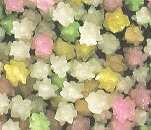HOME PAGE

CAKE & SNACK
Kastella

Dorayaki

Kompeitoh

DRESSING

GARDENING

GREEN TEA
Varieties

Preparation

When
and where

Benefits

PICKLES
Beer-zuke

Hakumai-zuke

Bettara-zuke

NATTO

SUSHI
Rice

Nigiri-zushi

Hako-zushi

Temaki-zushi

Masu-zushi

 Kompeitoh is a sugar ball of about 1/4 in diameter with many horns,
and has a history of more than 400 years in Japan.
Luis Frois, a Catholic missionary from Portugal, wrote the oldest
record about kompeitoh in his report to Pope in Rome.
According to his report,
he brought a glass jar of kompeitoh as one of the souvenirs
to Nobunaga Oda in 1563.
Kompeitoh is a sugar ball of about 1/4 in diameter with many horns,
and has a history of more than 400 years in Japan.
Luis Frois, a Catholic missionary from Portugal, wrote the oldest
record about kompeitoh in his report to Pope in Rome.
According to his report,
he brought a glass jar of kompeitoh as one of the souvenirs
to Nobunaga Oda in 1563.  Kompeitoh intrigued Japanese,
but it took long time before they learned how to make it.
More than one hundred years later, Saikaku Ihara, a famous writer in Edo era,
wrote about a man who became rich
by inventing a method of manufacturing kompeitoh.
Kompeitoh intrigued Japanese,
but it took long time before they learned how to make it.
More than one hundred years later, Saikaku Ihara, a famous writer in Edo era,
wrote about a man who became rich
by inventing a method of manufacturing kompeitoh. In old days, popy seed or sesami seed was used as a core of kompeitoh. Seeds were coated with sugar first. Then the horns were grown. In the modern method of manufacturing kompeitoh, no seed is necessary.
Many Japanese who love Tchaikovsky's ballet music, The Nutcracker (1891-1892), think kompeitoh was popular in Europe, because a piece of music in the suite played by a keyboard instrument, celesta (footnote a), is titled Kompeitoh's Dance in Japanese. This title is a translation made long time ago from the original title, Dance de la Fee-Dragee in French. Dragee is sugar-coated almond, and traditionally served at weddings in Europe. Nothing like Japanese kompeitoh can be found, however, in French or Russian food history. To those who know kompeitoh, nonetheless, the music played by a celesta sounds really like dance of tiny kompeitohs than sugar coated almonds. This is why Nakata speculates that the composer may have seen kompeitoh somewhere, possibly on his trip to the United States, and really meant it but used the word Dragee because kompeitoh was not known in Russia.
For more details about kompeitoh, the book written by Tomoichi Nakata is recommended (see footnote b). In North America, kompeitoh may be found more easily in Chinese grocery as "Starlet" than Japanese.
Footnote
a: A percussion musical instrument invented in Paris, 1886, consisting of steel bars connected to a keyboard.
b: Tomoichi Nakata is a faculty member in Mathematics at Chukyo University in Nagoya. His publications include:
- T Nakata. Hello Kompeitoh. Akane-Book Publishing, 1995 ISBN-251-03902-5
- N Murai, T Nakata. Rounded Spikes of Kompeitoh and Scaling Relations. Am. J. Physics, 1988